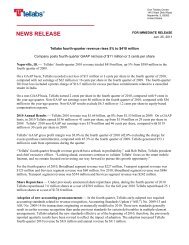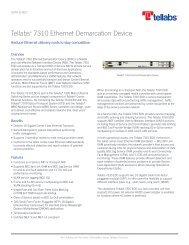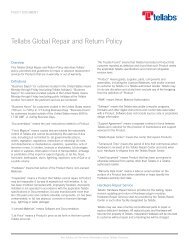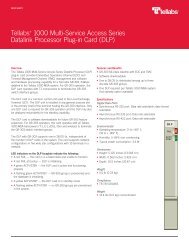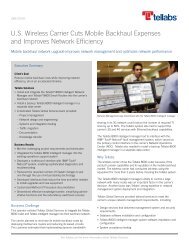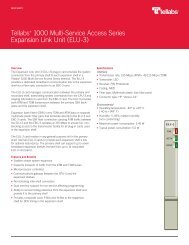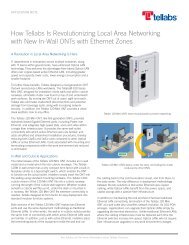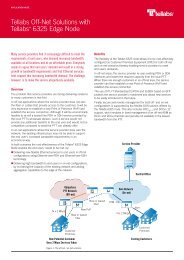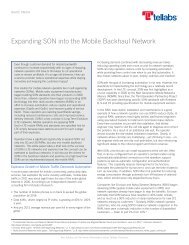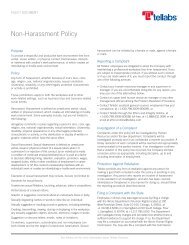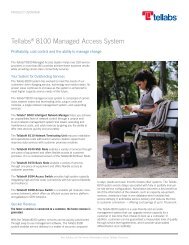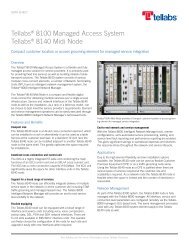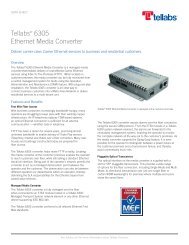Telstra Scales Up - Tellabs
Telstra Scales Up - Tellabs
Telstra Scales Up - Tellabs
- No tags were found...
Create successful ePaper yourself
Turn your PDF publications into a flip-book with our unique Google optimized e-Paper software.
leading edgeCan you afford to be blind tothe apps in your network?Thanks to the mobile Internet revolution, change is zipping throughour industry faster than a bullet train. We all want to boost networkperformance, ensure a good user experience and improve businessresults. The catch is: trying to do all that with blinders on.We see blind spots around critical questions: Which applications arenetworks carrying? What are users really experiencing? Are we ready forfuture requirements?Mike Wright, <strong>Telstra</strong>’s executive director for networks and accesstechnologies, sums up the situation: “We need to understand how thenetwork is used.” By adding the new <strong>Tellabs</strong> SmartCore ® 9200 Seriesto its next-gen network, <strong>Telstra</strong> is gaining applications awareness,OA&M beyond Layer 3, the lowest cost-per-bit and maximum flexibilityfor the future (page 8).Our new <strong>Tellabs</strong> SmartCore 9200 series is all about makingnetworks—including converged and mobile networks—smarter andsimpler. It gives you visibility to apps, ways to make money on overthe-toptraffic, and built-in flexibility to meet emerging requirements(page 11).Customers want a deep understanding of the user experience, andthe means to correlate it with network performance. Our new <strong>Tellabs</strong>Insight Analytics SM services provide end-to-end analytics, integrate datafrom many sources across the network, and help you see clearly what’sgoing on in networks and with users (page 6).As mobile carriers migrate to packet networks, synchronizationcan be a stumbling block. Rather than keep legacy equipment just forsynchronization, <strong>Tellabs</strong> ® 8600 Managed Edge System customers aresimplifying their networks and synching up with the new IEEE 1588v2standard (page 13).As our industry hurtles forward to realize the full potential of the mobile Internet, smarter and simpler networks arethe key. That’s why we’re investing 25% of <strong>Tellabs</strong>’ revenue to design the best next-gen product portfolio for the smartmobile Internet. We’re backing up this portfolio with some of the industry’s best sales, service and tech support people,so we can take good care of you.We’re ready to help you answer the critical questions, and help you succeed with users, networks and your business.Sincerely,“Our new <strong>Tellabs</strong> SmartCore9200 series is all about makingnetworks—including convergedand mobile networks—smarterand simpler.”— Robert Pullen, President and CEO, <strong>Tellabs</strong>Rob PullenPresident and CEOSubscribe to Insight: www.tellabs.com/insight <strong>Tellabs</strong> Insight Q4 | 3
upload<strong>Tellabs</strong> on Track to Reduce CarbonFootprint 20% by 2013Throughout 2011, Insight profiled service providers that are reducingenergy consumption to benefit the environment, their customers andtheir bottom lines. That’s not the only reason it’s a familiar story at<strong>Tellabs</strong>. Since 2008, the company has reduced its carbon footprint13%, the equivalent of taking 1,000 cars off the road.Three years ago, <strong>Tellabs</strong> began participating in the Carbon DisclosureProject (CDP), the world’s largest database of corporate greenhouse gasemissions. The CDP provides methodology to ensure that all participantsmeasure their emissions the same way.<strong>Tellabs</strong>’ CDP reports include the company’s major internationaloffices in countries such as China and Finland. In early 2010, theFinland offices switched to electricity produced by hydropower, which<strong>Tellabs</strong> predicted would reduce carbon emissions by almost 2,100metric tons in the first year.The switch to hydropower is a major reason why <strong>Tellabs</strong>’ globalcarbon footprint shrank 5% over the past year. By 2013, <strong>Tellabs</strong> expectsto reduce emissions 20% per employee compared with 2008. Thosekinds of goals and results are among the reasons why the MaplecroftClimate Change Innovation Index, FTSE4Good and 8 FTSE KLD indexesconsider <strong>Tellabs</strong> a responsible investment.To see <strong>Tellabs</strong>’ CDP reports for 2008 through 2011, visit www.tellabs.com/about/reports.shtml. And to learn how operators such as Bharti-Infratel, Comcast, Verizon Wireless and Vodafone save energy, check outthe 2011 editions of Insight at www.tellabs.com/news/insight. •<strong>Tellabs</strong> Greenhouse Gas EMISSIONSAdditional details are available in <strong>Tellabs</strong>’ responses to CarbonDisclosure ProjectTotal emissionsScope 3Scope 2Emissions per capita13.9912.5711.50Scope 12008 2009 2010 2008 2009 2010We measure GHG emissions in metric tons of carbon dioxideequivalents (tCO2e).Target11.19NTT CommunicationsThanks <strong>Tellabs</strong> forHelp After EarthquakeThe earthquake andtsunami that struckJapan in Marchdisrupted telecomservices throughoutthe country. Tohelp its longtimecustomer NTTCommunicationsrecover quickly,<strong>Tellabs</strong> providedreplacements for 11 <strong>Tellabs</strong> ® 8800Multiservice Router 10GE modulesdamaged in the disaster.In June, NTT Communications’Network Business Division handdelivereda letter expressing thecompany’s thanks for the quickresponse. “<strong>Tellabs</strong> has made asignificant contribution to NTTCom andour network service by promptly sendingreplacements,” wrote Yukio Ito, vicepresident and executive manager of NTTCommunications’ Network BusinessDivision. “NTTCom would like to showdeep appreciation to <strong>Tellabs</strong> for givingthe highest priority and quick action tothis issue.”NTT Communications has been a<strong>Tellabs</strong> customer since 2003, whenit began using the <strong>Tellabs</strong> 8800Multiservice Router 10GE modulesto support its IP/MPLS network withEthernet service delivery. (For anin-depth look at NTT Communications’IP/MPLS strategy, visit www.tellabs.com/insight and check out “NTT ComLooks to Blaze New Trails” in the March2009 issue.)“We are glad that we could help ourJapanese customers,” said MichaelStephens, <strong>Tellabs</strong> director for customerservice in the Asia-Pacific region. “Theearthquake and tsunami have taken manylives and destroyed a substantial amountof infrastructure there. We wanted to helpthem restore services and help get thebusiness back on its feet.” •4 | <strong>Tellabs</strong> Insight Q4 subscribe to Insight: www.tellabs.com/insight
What Are Your CustomersReally Experiencing?If you think monitoring network performance provides anaccurate picture of the mobile user experience, think again.By M.J. RichterMobile operators know that enough poor experiences willdrive their customers into their competitors’ arms. Thatexodus negatively impacts churn and ARPU—2 metrics thatanalysts and investors watch like hawks—while the sulliedbrand increases user-acquisition costs.But when it comes to managing the user experience,the traditional bottom-up approach of monitoring networkperformance rarely reaches the customer-experience level.In this traditional environment “the operations guys wouldanalyze the network, the billing people would analyze billingand the customer-service people would analyze performancemetrics,” said Becky Watson, principal analyst with Stratecast,a division of Frost & Sullivan.“I do not believe that operators can actually determinequality of experience unless they have a very robust analyticsstrategy. What has to happen for quality of experience to betruly realized is bringing all of that together.”Start with the User ExperienceEffectively managing the user experience requires a topdownview. That process starts with the user’s actualexperience and then drills across and down into everyaspect of the network that affects that experience at auser level.To carry out such a comprehensive inspection of everynetwork aspect, an analytics solution must be basedon enterprise analytics rather than integrated real-timeanalytics.An operator’s engineering and operations groupstypically use integrated real-time analytics tools inthe areas of policy enforcement, PCRF and security.Because there’s little data-storage capacity within thatsingle network element, integrated real-time analyticstools cannot make historical comparisons or perform anytrending analyses.Enterprise analytics, on the other hand, involves thecollection of data from multiple elements and backofficesystems across the network. It also includes the correlation ofthose information sets and their analysis to gain key insights.The ideal end-to-end analytics solution should:• Collect information from network elements, probesand back-office systems, feeding the information into ahighly scalable analytics platform.• Correlate those different information sets into unique,repeatable algorithms.• Apply analytic logic, modeling and mathematics in theform of advanced statistics and business calculus.• Produce configurable and distributable dashboards,views and reports, all tailored to meet the uniquerequirements of each business staff group, such asengineering, operations, marketing, customer careand product management, with the intent of providingactionable insights for each audience.6 | <strong>Tellabs</strong> Insight Q4 subscribe to Insight: www.tellabs.com/insight
What Are Your Customers Really Experiencing?“End-to-end analytics enables you to look at the customerexperience, isolate performance anomalies, do root-causeanalysis and make the necessary changes to the network,”said Scott Forbes, <strong>Tellabs</strong> director of professional services.“You know those changes improve the user experiencebecause you can actually measure the improvements.”“By contrast, the best an operator can do with thetraditional network monitoring approach is to focus on theavailability and performance of the network, make changesto the network and hope they improve the user experience asa result.”Analyze, Then ActUsing new analytics platforms, in conjunction with correlatingmultiple data sources in a single, centralized system,operators now can capture, monitor and measure every usersession leveraging all of the pertinent data points. Althoughthey don’t look at the content of what the user is doing, theycan see exactly how the session is performing, all the wayfrom the device through the network and out to the Internet.This design balances user concerns about privacy with theoperator’s need for deep insights.As a result, operators can take action before usershave negative experiences on the network and then callin to complain. Users typically don’t complain after 1 badexperience but rather after 4, 5 or 6 bad experiences. Bythen, they’re so frustrated that they often decide they’ve hadenough and switch to another operator.An advanced analytics solution enables engineers toproactively get ahead of problems instead of reacting to a“I do not believe that operators can actually determine qualityof experience unless they have a very robust analytics strategy.What has to happen for quality of experience to be trulyrealized is bringing all of that together.”— Becky Watson, principal analyst with Stratecast, a division of Frost & Sullivancomplaint by adding more capacity or applying some kind ofbandage to fix it. By constantly monitoring and measuringthe user experience, this solution enables the operator todo a targeted root-cause analysis when the user experiencedegrades. The operator then can correlate that analysiswith the user experience to determine what’s affectingthat experience and resolve the issue quickly—and beforecustomers call to complain.For example, if something in the network goes down,legacy analytics tools cannot to help the operator determinehow many users are affected or whom the affected users are.However, an advanced analytics solution can use its analyticalcapabilities to answer both questions. It can pull up theMSIDs, which are unique to each mobile customer, correlateTo help operators isolate any issue affectingthe user experience, the analytics solutioncan identify and correlate:• The specific application being used duringa good/bad/poor experience.• The time of day the customers are using it.• The components of the network that their sessionstraversed.• The websites that customers’ applications used andwhether they did so directly or via browser-basedsearches. Likewise, whether the customers were playinggames through connections to gaming servers.• The IP addresses of the websites or gaming serversand, depending on the operator’s specified level ofgranularity, the associated URLs.them with CRM data and supply relevant demographic dataabout each affected user.When the analytics solution determines that someuser experiences are degrading, the operator can examinepossible reasons and focus on the areas of the network whereanomalies are occurring: Is it a network-configuration issue? Isit some type of problem with those users’ mobile devices? Oris it something else altogether?The user experience can be rated numerically and thenranked as good, bad or poor. If a user has multiple sessionsper day, scores are correlated, providing a mean score for theoverall experience. Operators also can store these scores in adatabase for tasks such as historicaland trending analysis. Based on theuser experience data, operators canisolate which part(s) of the networkmay have degraded the experienceand do a targeted root-cause analysisto identify the actual problem.“Then expert teams can say:‘You have issue X, and we think this sub-set of users is mostlikely to churn as a result. You might want to resolve it bydoing Y, and here’s the business justification for consideringthe various options available,” Forbes said. “Through preciseroot-cause analyses, operators can actually solve underlyingnetwork problems to proactively manage the user experienceand ultimately reduce churn. This is a direct correlationbetween user experience and network performance.” •ARPU: AverageRevenue Per UserCRM: Customer RelationshipManagementMSID: Mobile SubscriberIdentificationIP: Internet ProtocolPCRF: Policy, Chargingand Rules FunctionURL: Uniform Resource LocatorSubscribe to Insight: www.tellabs.com/insight <strong>Tellabs</strong> Insight Q4 | 7
<strong>Telstra</strong>’sTransformationAustralia’s largest operator leveragesthe new <strong>Tellabs</strong> SmartCore ® 9200Series for its Multi-Service EdgeNext Phase project.By Joan EngebretsonMike Wright, <strong>Telstra</strong> executive directorfor networks and access technologiesMike Wright has his hands full. As <strong>Telstra</strong>’s executive directorfor networks and access technologies, he’s in charge ofthe Australian operator’s latest ambitious project: doublenetwork capacity, introduce a next-generation content routingplatform and reduce network costs through upgrades to itsaggregation network.“The network is largely about maintaining network scaleand managing growth, as well as taking evolutionary steps toimprove reliability, enhance efficiency and expand services,”Wright said.A critical element of this plan is a new edge router, the<strong>Tellabs</strong> SmartCore ® 9200 Series, which <strong>Telstra</strong> plans to deployin 2012. <strong>Telstra</strong> also will deploy a new universal line card, anew Ethernet and IP line card and a new switch and controllercard for the <strong>Tellabs</strong> ® 8800 Multiservice Router Series (MSR),which <strong>Telstra</strong> has used since 2005.Currently under development, the <strong>Tellabs</strong> SmartCore 9200series is a high-performance IP and Ethernet platform capableof scaling to 1 Tbps per slot and 11 Tbps per chassis, offeringample support for future network expansion.“The <strong>Tellabs</strong> SmartCore 9200 series really builds on thesuccess of the <strong>Tellabs</strong> 8800 MSR series as a carrier-classedge routing platform, supporting IP/MPLS and Ethernetin a highly scalable solution with industry-leading capacityand application-oriented routing,” said Tim Doiron, directorof product management for the <strong>Tellabs</strong> IP and MobileInternet group.New Year, Twice the TrafficOver the past several years, <strong>Telstra</strong> has consolidated moreand more traffic onto an MPLS and IP core. To support thatevolution, <strong>Telstra</strong> deployed the <strong>Tellabs</strong> 8800 MSR series in alarge portion of its network. <strong>Telstra</strong> has deployed nearly 300<strong>Tellabs</strong> 8800 MSR series nodes and plans to add more overthe next 18 months.<strong>Telstra</strong> initially moved Frame Relay and ATM traffic onto its<strong>Tellabs</strong> 8800 MSR-based MPLS network, leveraging the <strong>Tellabs</strong>8800 MSR’s unique ATM PNNI-to-Ethernet interworkingfunctions. Later the operator moved traffic from residentialbroadband customers onto the MPLS network, as well. This8 | <strong>Tellabs</strong> Insight Q4 subscribe to Insight: www.tellabs.com/insight
<strong>Telstra</strong>’s Transformationnetwork also supports Ethernet services and mobile backhaul.Traffic on <strong>Telstra</strong>’s aggregation network has been growingdramatically. For example, the residential broadband portiondoubles every 12 months.“We want to make sure we can continue to support strongtraffic growth,” said Arturo Cacace, technology manager for<strong>Telstra</strong>’s Ethernet infrastructure and services. “We would liketo expand our service offerings, enhance network reliability andefficiency and minimize costs.”Those requirements are driving <strong>Telstra</strong>’s newest upgrade,known internally as Multi-Service Edge (MSE) Next Phase,which aims to further enhance the carrier’s aggregationnetwork according to a 2-phase plan.The first phase, known as MSE Gen 2, is already underwayand scheduled for completion in early 2012. In MSE Gen 2,<strong>Telstra</strong> is introducing 3 new cardsto the <strong>Tellabs</strong> 8800 MSR seriesthat will double network capacity,improve reliability, significantlyreduce cost per bit and add newcapabilities for Ethernet servicedelivery.In the second phase, scheduledto begin in mid-2012, <strong>Telstra</strong> willdeploy the <strong>Tellabs</strong> SmartCore9200 series, which expands on thecapabilities of the <strong>Tellabs</strong> 8800MSR series.“We plan to use the <strong>Tellabs</strong>SmartCore 9200 series to provideadditional scalability, reliability andnetwork efficiencies, ultimately reducing network costs,” saidDavid Robertson, <strong>Telstra</strong> director for transport and routingengineering. “In addition, the <strong>Tellabs</strong> SmartCore 9200 seriescan provide a platform for next- generation services.”Change is in the CardsThe <strong>Tellabs</strong> 8800 MSR series nodes, which are part of<strong>Telstra</strong>’s MPLS-based aggregation network, are todayequipped with the <strong>Tellabs</strong> universal line card (ULC-2).<strong>Telstra</strong> now plans to upgrade trunks and spares to the ULC-3, a next-generation universal line card that has a revised ASIC,a faster CPU and more RAM. <strong>Telstra</strong> expects the ULC-3 toimprove performance and increase network reliability.“By using the latest platform, we get better scale andreliability and lower unit cost,” Wright said.<strong>Telstra</strong> also plans to upgrade the switch and controller card(SCC-1) that is currently deployed in the <strong>Tellabs</strong> 8800 MSRseries to a next-generation version of the card, the SCC-2.That upgrade will more than double chassis capacity, from120 GB to 288 GB. Slot capacity and Ethernet port densitywill double, as well.“We plan to use the <strong>Tellabs</strong>SmartCore 9200 series toprovide additional scalability,reliability and networkefficiencies, ultimately reducingnetwork costs. In addition,the <strong>Tellabs</strong> SmartCore 9200series can provide a platformfor next-generation services.”— David Robertson, <strong>Telstra</strong> director fortransport and routing engineering“Instead of the traditional hard disk drive, the SCC-2 usessolid-state storage,” said Andrew Roberts, a sales supportengineer for <strong>Tellabs</strong> who has been closely involved in <strong>Telstra</strong>’snetwork upgrade plans. “That is one of the several designupdates on SCC-2 that enhance network reliability.”The third new line card that <strong>Telstra</strong> will deploy is theEthernet line card (ELC), which the carrier will use to supportbusiness Ethernet services. The new ELC is a more optimizedway to deliver Ethernet with a higher density and lower priceper port.The move to the ELC at this time makes sense for<strong>Telstra</strong> because of the strong growth the carrier is seeingin Ethernet services. “If you look at our growth statistics,the real explosion is in Ethernet, DSL and wireless,” Wrightsaid. Using the ELC is a good move because the productrepresents “the latest generationtechnology with lower powerconsumption and lower unit cost.”Better Awareness,Enhanced ReliabilityBesides providing ample room forgrowth, the <strong>Tellabs</strong> SmartCore9200 series also gives <strong>Telstra</strong> somepowerful new tools.“The <strong>Tellabs</strong> SmartCore 9200series incorporates applicationawareness and OA&M capabilitiesbeyond Layer 3 to help serviceproviders understand what userapplications drive their network,”Doiron said. “Those insights enable them to both designaccordingly and offer new revenue-generating opportunities.”Another capability of the <strong>Tellabs</strong> SmartCore 9200 series isbuilt-in support for a 3G and LTE packet core. Although <strong>Telstra</strong>has no plans to adopt a packet core architecture immediately,the carrier likes the fact that the <strong>Tellabs</strong> SmartCore 9200series will enable it to easily add that capability in the future.The <strong>Tellabs</strong> SmartCore 9200 series also has severalfeatures aimed at enhancing reliability, including solid-statestorage, the new <strong>Tellabs</strong> GeniOS carrier-grade operatingsystem and a redesigned software architecture.“We’re always looking for the right time and opportunityto move to the next greater scale solution,” Wright said. Akey driver of the planned deployment, Wright said, is “toput the latest generation of the <strong>Tellabs</strong> platform into ournetwork and use it to drive the most flexibility and lowestcost moving forward.”The <strong>Tellabs</strong> SmartCore 9200 series “has a lot of optionalfeatures to build future products on,” Wright said. A contentand security engine can provide the ability to “betterunderstand how different customers are using the networkSubscribe to Insight: www.tellabs.com/insight <strong>Tellabs</strong> Insight Q4 | 9
<strong>Telstra</strong>’s TransformationThe <strong>Telstra</strong> team:David Robertson,director fortransport androuting; MarkLatham, seniortechnologyspecialist; ArturoCacace, technologymanager.and over time, offer different servicelevels for different applications.” Thisfunctionality is built directly into the<strong>Tellabs</strong> SmartCore 9200 series’ linecards, enabling content inspectiondirectly on line cards interfacing thenetwork and making efficient use ofprecious chassis ports.To develop those services,“we want to understand how thenetwork is used,” Wright said. Byenabling operators to maintain andanalyze aggregate data about the types of applications thatcustomers are using, application awareness can help gain thatunderstanding.Initially <strong>Telstra</strong> plans to deploy the <strong>Tellabs</strong> SmartCore 9200series in “high-density parts of the network, where scale isneeded or where we are looking to drive new services, suchas DPI-based services,” Wright said. “We will continue to usethe <strong>Tellabs</strong> 8800 MSR series in areas where Ethernet growthrequirements are not as explosive.”Familiarity Breeds ContentDespite all of these upgrades, managing the new equipmentshould require minimal new training or procedures. That’sbecause <strong>Telstra</strong> will be able to manage its <strong>Tellabs</strong> networkwith a single, unified network manager for both the <strong>Tellabs</strong>SmartCore 9200 series and the <strong>Tellabs</strong> 8800 MSR series.“We look at a lot of equipment from a lot of vendors,”Wright said. “One of the biggest factors we take into accountas an operator is to maintain continuity in IT systems. <strong>Tellabs</strong>’“We want to make sure wecan continue to support strongtraffic growth. We also want toexpand our service offerings,enhance network reliability andefficiency and minimize costs.”— Arturo Cacace, <strong>Telstra</strong>technology manager, Ethernetinfrastructure and servicesmanager makes integration easier andthe decision to upgrade easier as well.”That continuity includes somefamiliar faces. The <strong>Tellabs</strong> GlobalServices team has supported severalother major <strong>Telstra</strong> projects, includingits Next IPTM network. (For moreinformation about Next IP, visit www.tellabs.com/insight and check out“Another Step for <strong>Telstra</strong>’s Next IPRollout” in the Q3 2011 Insight.) Thatrelationship continues with the MSE Gen2 program and the <strong>Tellabs</strong> SmartCore 9200 series rollout.“By working closely with <strong>Tellabs</strong> Global Services, we can getthe most out of the platform,” Wright said. “We benefit fromhaving their experts working with us.”A team of <strong>Tellabs</strong> Global Services personnel is focused100% on <strong>Telstra</strong> and even have desks located in <strong>Telstra</strong>offices. This close collaboration helps <strong>Tellabs</strong> in mapping outthe direction of future products, Wright said. By working closelywith <strong>Tellabs</strong> Global Services on an ongoing basis, Wright said<strong>Telstra</strong> has “direct input into where the partnership is going anda direct feed into the product area at <strong>Tellabs</strong>.” •3G: Third GenerationASIC: Application-SpecificIntegrated CircuitATM: AsynchronousTransfer ModeCPU: Central Processing UnitDSL: Digital Subscriber LineIP: Internet ProtocolLTE: Long-Term EvolutionMPLS: MultiprotocolLabel SwitchingOA&M: Operations, Administrationand MaintenanceRAM: Random Access MemoryTDM: Time Division Multiplexing10 | <strong>Tellabs</strong> Insight Q4 subscribe to Insight: www.tellabs.com/insight
Ready for AnythingThe new <strong>Tellabs</strong> SmartCore ® 9200 Seriesenables smarter, simpler networks.By M.J. RichterWhen it comes to predicting the future of the mobileInternet and converged Ethernet networks, the only sure betis that they will keep growing and changing at an ever-fasterclip. That constant change means operators must preparetheir networks to handle just about anything.Operators have stayed on top of the most recent mobileInternet and user trends by deploying solutions for IP/Ethernetand backhaul, the mobile packet core and flatter packetnetworks. Now they seek products and strategies that willposition them to catch the next wave of changes, which likelywill include:• The dominance of multimedia in the traffic mix.• The rapid expansion of cloud/hosted servicesand virtualization.• The movement of billions of users and smartdevices onto networks.• Common services across multiple screens and networks.• Domination of the marketplace by over-the-top providers.• The need for massive network scalability—and in multipledimensions, not just raw capacity.• New monetization models to bolster operators’long-term success.To accommodate these coming changes, operators need anew class of network. Those networks must be smart, simple,scalable and adaptable enough to improve both users’ qualityof experience and operators’ profitability.An Evolutionary Path to the FutureThe foundation of that new class of network is the <strong>Tellabs</strong>SmartCore ® 9200 Series, a massively scalable, content-awarerouting platform designed to:• Give operators visibility into their networks.• Provide secure services.• Equip the network to predictably deliver any and all kindsof content.• Enable operators to generate revenues from that content.The <strong>Tellabs</strong> SmartCore 9200 series is the most recentaddition to the <strong>Tellabs</strong> portfolio of mobile and metro Ethernetsolutions. Featuring the new <strong>Tellabs</strong> GeniOS operatingsystem, the <strong>Tellabs</strong> SmartCore 9200 series functions initiallyas an intelligent IP edge router.Just as important, the <strong>Tellabs</strong> SmartCore 9200 series’architecture enables networks to keep pace with comingmobile Internet and user developments. For example, byFeaturing the new<strong>Tellabs</strong> GeniOSoperating system,the <strong>Tellabs</strong>SmartCore 9200series functionsinitially as anintelligent IPedge router.Subscribe to Insight: www.tellabs.com/insight <strong>Tellabs</strong> Insight Q4 | 11
Ready for Anythingadding software application modulesto the <strong>Tellabs</strong> SmartCore 9200 series,operators over time can expand theircapabilities. These capabilities includecontent and security engines integratedonto line cards for application awareness,analytics, IPSec security termination andeventually packet core functionality.“An operator may deploy the<strong>Tellabs</strong> SmartCore 9200 series as anaggregation Ethernet router today, butwhat that operator really is deploying isa large toolkit,” said Tim Doiron, <strong>Tellabs</strong>director of product management. “Withit, the operator can infuse the networkwith so much flexibility that it can adaptto just about anything the mobile Internetthrows at it in the years to come.”Intelligence for the FutureThe <strong>Tellabs</strong> SmartCore 9200 seriesfeatures high-density intelligence in the form of SmartCards,as well as distributed routing. Together, these features providethe network visibility and service-optimization capabilitiesoperators need to stay ahead of the fast-changing mobileInternet.SmartCards are fully swappable among all <strong>Tellabs</strong>SmartCore 9200 series chassis and include multiple interfaceoptions, such as Nx10 Gbps, NxGbE, and Nx100 Gbps.SmartCards eliminate the need for function-specific serverblades, spare blades and cards that have no Ethernet interfacefunctionality. They are available in 3 versions:• SC-1: designed for high-density Ethernet applications.• SC-2: identical to SC-1 density plus on-board contentand security engines for added intelligence capabilities• SC-3: increased content and security engine processingfor applications requiring full-rate or higher densitypacket inspection.“By combining traffic management, compute processingand security encryption all on a single card, the SmartCardgives you logical scalability and resource virtualization,”Doiron said. “So if a card has maxed out some dimension ofits capacity, it can use another card’s available capacity orintelligence, giving you even greater scalability.”5 Dimensions of ScalabilityThe SmartCards, together with the new, fully distributed<strong>Tellabs</strong> GeniOS operating system, enable the <strong>Tellabs</strong>SmartCore 9200 series to deliver scalability across 5dimensions: data throughput, control plane, encryption,packet inspection and traffic management. Each of thesefactors are critical as operators adapt their networks to userand traffic trends, and maximizeuser quality of experience andoperator profitability.In terms of bandwidth scalability,the <strong>Tellabs</strong> SmartCore ® 9280platform is a 10 Tbps-plus chassisin a 16 Rack Unit form factor,while the <strong>Tellabs</strong> SmartCore ® 9240platform is a more dense 4-slot,4-Tbps-plus 6 RU chassis.The platform’s first iterationwill deliver 100 Gbps per slotand is designed to scale upwardsof 500 Gbps per slot, or 1 Tbpshalf-duplex as operator demandsdictate. Thus, the <strong>Tellabs</strong>SmartCore 9200 series will providea 5-fold capacity improvement overtime.A new kind of operating systembuilt for next-generation networks,<strong>Tellabs</strong> GeniOS supports multidimensional scalability. Italso enables node and network virtualization and featuresAPIs for third-party applications.The <strong>Tellabs</strong> SmartCore 9200 series’ ability to ensureoptimal network performance stems from its distributedrouting, processing and forwarding design. Fully distributedrouting “will become more and more valuable to mobileoperators as they start targeting the embedded devicesspace, which will become increasingly dependent on IPv6,”said Patrick Donegan, Heavy Reading senior analyst.The <strong>Tellabs</strong> SmartCore 9200 series is also interoperablewith existing <strong>Tellabs</strong> products and is managed bythe <strong>Tellabs</strong> ® 8000 Intelligent Network Manager. Thisinteroperability enables the <strong>Tellabs</strong> SmartCore 9200 seriesto fit neatly into the network to pave an evolutionary path tohigher Ethernet density, improved cost-per-bit economicsand overall scalability.For example, the <strong>Tellabs</strong> SmartCore 9200 series pairswell with the <strong>Tellabs</strong> ® 7300 Metro Ethernet SwitchingSeries for Layer-2 services and applications. Combined withthe newly released <strong>Tellabs</strong> ® 8609 Access Switch, it canserve as a Layer 2/Layer 3 Ethernet- and TDM-based cellsiteand access solution.With that line-up, <strong>Tellabs</strong> provides not only a full suite ofmobile solutions, from the cell site all the way to the core,but also a new class of network that enables operators tosupport the smart mobile Internet. •The <strong>Tellabs</strong> SmartCore 9200series is interoperable withexisting <strong>Tellabs</strong> products. It fitsneatly into the network to pave anevolutionary path to higher Ethernetdensity, improved cost-per-biteconomics and overall scalability.API: ApplicationProgramming InterfaceIP: Internet ProtocolIPSec: Internet Protocol SecurityTDM: Time Division Multiplexing12 | <strong>Tellabs</strong> Insight Q4 subscribe to Insight: www.tellabs.com/insight
Time is MoneyAs they migrate to packettransport, mobile operatorsexplore synchronization optionssuch as IEEE 1588v2.By Tim KridelLike the meter in a taxi, the clock signal in a wirelessnetwork ultimately is about money. If the base stationslose timing, handovers will fail and calls will drop,costing the operator revenue.There’s now a new way that timing is money. As mobileoperators migrate to packet transport, many of them areleaving TDM infrastructure at each base station simply toprovide timing.“A lot of carriers are keeping an E1 or a DS-1 at thecell site purely for synchronization,” said Patrick Donegan,Heavy Reading senior analyst. “That’s inefficient. There’sa cost associated with that that you need to get out of thenetwork.”And it’s a big cost.“One E1 can cost several hundred Euros per month,”said Tuuli Sarvilinna, group product manager for the<strong>Tellabs</strong> ® 8600 Managed Edge System. “If you multiplythat by 5,000 or 10,000 base stations, that’s a hugeamount of money.”Why Not GPS?At other operators, the E1s/T1s still carry voice and data,but from both a capacity and financial perspective, theirdays are numbered. Although those operators know they’lleventually have to switch to packet transport, many areunaware of the sync considerations that come with thatmigration.Some operators are considering GPS, which is a maturetechnology. Its drawbacks include the cost of addingGPS equipment to every base station and the lack of GPScoverage in certain areas, such as inside buildings.“Reliance on GPS is also a concern for some operatorsthat point to reports of jamming and the U.S. governmentownership of GPS,” Sarvilinna said.Fortunately other technologies exist that provide thenetwork-wide clock synchronization necessary for taskssuch as handovers. One option is SyncE, which has theEthernet features of IEEE 802.3 and, thanks to the ITU-T,the synchronization features of SDH/SONET.The second major option is 1588v2. The IEEEspecified 1588v2’s protocol suite, including the boundaryand transparent clocks. The ITU-T specifies the servicesavailable both with and without boundary clocks.Vodacom is among the operators that currently useGPS but plan to curb further deployment as part of theirEthernet migration.“Once the access network and core network are basedon IP, the 2 options for access are 1588v2 and/or SyncE,”said Sean Moss, Vodacom principle specialist. “The mainadvantage of 1588v2 is it can supply phase and frequencyover a packet network and is more cost-effective than GPSat every site.”“Any 2 Will Do”The number of base stations worldwide using 1588v2will grow from 48,000 today to 1.3 million by the end of2015, Heavy Reading predicts. That’s an increase from20% of all Ethernet-fed sites today to 43% by 2015.“My assumption is that 1588 will go on to be themost widely deployed [solution] over the next few years,”Donegan said.But that’s not the same as saying that 1588 eventuallywill be the only solution.“A lot of operators will deploy more than one standard,”Donegan said. “There is a view amongst many operatorsthat the right philosophy for this transition is ‘any 2will do.’ There are circumstances where GPS will workperfectly well, but not deep in buildings. I see prettystrong demand for SyncE, as well.”France Télécom Orange is one example.“France Télécom Orange is actively investigating SyncEas a first priority and PTPv2/1588 as a second priority,” saidSébastien Jobert, Orange expert on network synchronization.“GPS and Galileo may also be considered for specificcases. With a longer term perspective, it is expected thatSubscribe to Insight: www.tellabs.com/insight <strong>Tellabs</strong> Insight Q4 | 13
Time is MoneyFrom E1/T1 to 1588 in 3 Easy Steps.E1/T1only forsyncTDM network1588v2masterE1/T1/FE/GE1588GE/FE forservicesPacketnetworkGE10GE8600RCN1 Configure 1588 as back-upreference. Enable monitoring.2 Prefer 1588 over E1/T1.Monitoring continues.3Remove E1s/T1s.PTPv2 would also be able to provide accurate phase/timesynchronization, possibly combined with SyncE.”Many operators are waiting for standards work to befinalized before committing.“Important work is on-going at ITU-T with regards to thedefinition of PTPv2 telecom profiles,” Jobert said. “This workneeds to be finalized to make PTPv2 a mature solution fortelecoms applications.”No New Hardware NeededSome mobile operators can implement 1588 immediatelyand with no new infrastructure. They’re the ones that currentlyhave the <strong>Tellabs</strong> 8600 system, which has been upgradeable tosupport 1588 since 2007.That upgradeability is why <strong>Tellabs</strong> currently is one of thefew vendors with customers running 1588.“They have live, commercial deployments, and noteverybody does,” Donegan said.To enable 1588, operators simply load the necessarysoftware into their <strong>Tellabs</strong> 8600 system.“The operator doesn’t have to purchase any extra boxesto do packet synchronization in the network,” Sarvilinnasaid. “Everything is integrated, manageable and easily rolledout. We’ve focused on making that migration as painless aspossible.”An operator taking sync from the TDM infrastructurecan now use the <strong>Tellabs</strong> 8600 system’s monitoring featuresto trial 1588 on the live network without site visits or riskof disturbance. The operator can use the <strong>Tellabs</strong> ® 8000Intelligent Network Manager to configure, measure andvisualize 1588 performance network-wide and drill down intothe detailed TIE plots. Once the 1588 migration is complete,the <strong>Tellabs</strong> ® 8000 Intelligent Network Manager continuesto monitor 1588 health using packet metrics and TIE/MTIEmeasurement on sites with a reference.“They can monitor it on a large scale for performanceissues before actually throwing the switch and having the basestations take the clock from the 1588 client,” said KennethHann, <strong>Tellabs</strong> principal engineer. “It’s like having built-inmeasurement equipment on every site.”The Right Place at the Right Time<strong>Tellabs</strong> started planning 1588 support for products such asthe <strong>Tellabs</strong> ® 8605 Access Switch in 2007 while continuingto work with standards bodies such as IEEE and operators torefine the technology.“In 2002, we discovered that we could use Ethernet tocarry timing,” Hann said. “We built that into our productsway in advance of any activities in the ITU-T. From about2006, when the ITU-T adopted SyncE, we’ve been a regularcontributor to synchronization topics.”Today, <strong>Tellabs</strong> is prepared for LTE Advanced, which mostoperators likely won’t deploy until late this decade.“Even though it might be 3 to 5 years before they haveto accommodate it in their networks, it will be influencingtheir purchasing decisions today,” Hann said. “They wantto have at least an understanding that the equipment theybuy today can be software upgraded to support 1588 phasesynchronization, which gives them the accuracy they needfor LTE Advanced.” •GPS: Global Positioning SystemIEEE: Institute of Electricaland Electronics EngineersIP: Internet ProtocolITU-T: InternationalTelecommunication UnionTelecommunicationStandardization SectorLTE: Long-Term EvolutionMTIE: Maximum TimeInterval ErrorPTPv2: Precision Time ProtocolSDH: SynchronousDigital HierarchySONET: SynchronousOptical NetworkingSyncE: Synchronous EthernetTDM: Time Division MultiplexingTIE: Time Interval Error14 | <strong>Tellabs</strong> Insight Q4 subscribe to Insight: www.tellabs.com/insight
Analyst ViewpointThe Next-GenerationCentral OfficeService providers worldwide face big network changes and bigchallenges. With their massive data centers, Internet contentproviders such as Google, MSN and Amazon have permanentlychanged the basic patterns of Internet traffic.For example, video traffic growth alone is enough of a challenge.Now add the challenge of unpredictable traffic flowsbecause users access video not just from fixed networks, butfrom mobile devices anywhere. If operatorscontinue down today’s path of just buyingmore capacity without adding intelligence andmaking architectural changes, their businessmodels are doomed to unprofitability, theirnetworks will underperform and their customerswill churn to rivals with smarter networks.That’s why many service providers areoptimizing their networks in 2 major ways:• Moving toward a single network to support all services:fixed and mobile, private and Internet.• Developing next-generation central offices, whichInfonetics Research calls NG-COs.Our discussions and surveys with service providers worldwideshow that they’re considering several architectural optionsto handle fixed and mobile access, particularly for video. TheNG-CO is a location where traffic from both fixed and mobilecan be in edge routers. It’s a natural point of fixed-mobile convergence.But what’s an NG-CO?Currently, most metro networks have 10s to 100s of COs.Outbound traffic is funneled to a single, large Internet POP—the “super-POP”—that connects to the service provider’sBRAS: Broadband RemoteAccess ServerCapEx: Capital ExpensesCDN: Content Delivery NetworkFTTN: Fiber to the NodeIaaS: Infrastructure as a ServiceIP: Internet ProtocolService providersworldwide are migratingtoward a single networkfor all services, pairedwith a new breed of CO.By Michael HowardOLT: Optical Line TerminalPaaS: Platform as a ServicePON: Passive Optical NetworkPOP: Point of PresenceSaaS: Software as a ServiceWDM: Wave Division MultiplexingThe NG-CO is a locationwhere traffic from bothfixed and mobile canbe in edge routers. It’sa natural point of fixedmobileconvergence.inter-city, inter-country network and the Internet. Many functions,such as BRAS, are located in the super-POP.Operators such as BT have identified a few large COs in ametro—clustered around the super-POP—that will house distributedBRAS and other next-gen network functions, creatingNG-COs. In a large metro, there might be 5 to 10 NG-COs thataggregate traffic from the smaller COs and FTTN nodes.Many operators plan to deploy a variety of infrastructure andservices in NG-COs:• Caching/CDNs to significantly reduce metro, regional andbackbone traffic, especially video.• Adaptive video streaming to ensure an optimal viewingexperience on any screen with whatever bandwidth isavailable.• Mini data centers to offer cloud services such as IaaS andlocate latency-sensitive applications.• Distributed BRAS and mobile user management at thebest point to capture user behavior data to enable intelligentad.• Converging fixed and mobile access onto a single aggregationbackbone.• In the future, OLT aggregation points for next-gen accessnetworks such as WDM-PON.Cloud-Aware CapabilitiesWith these functions, NG-COs become partof a distributed, intelligent cloud resource. Intheir search for new revenue, many serviceproviders—such as Interoute, COLT andGTS in Europe—are expanding their datacenters to offer cloud services.Many operators are considering creatingmini data centers in NG-COs to offer PaaS, SaaS and IaaS.This architecture introduces more intelligence into the networkin a distributed fashion because content and applications arereplicated from originating data centers out to NG-COs. Thecomputing resources can be used for running applications suchas rich media and rendering, or latency-sensitive applicationssuch as gaming.Operators increasingly believe it makes sense to have“cloud-aware” capabilities—that is, mini data centers—in theirnetworks. In this way, carriers believe that NG-COs can becomepart of a distributed, intelligent cloud resource.These trends are well under way. One example is DeutscheTelekom’s project to reduce the number of COs in Germanyfrom 8,000 to 900. Another example is how most operators aremoving toward fewer or a single IP/Ethernet/WDM network. Thebottom line: Most operators are planning NG-COs. •Michael Howard is co-founder of Infonetics Research and principalanalyst for carrier networks. For more information, visitwww.infonetics.com.Subscribe to Insight: www.tellabs.com/insight <strong>Tellabs</strong> Insight Q4 | 15
Reward customers for using your network.Do you know how customers are using your bandwidth?A smarter network tells you what apps and services theyaccess most. Then you can offer pricing plans that area win for them…and you.Find out how. Get a free white paper atinfo.tellabs.com/analytics



